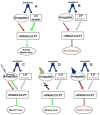Rewiring brain circuits to block cataplexy in murine models of narcolepsy
- PMID: 28445807
- PMCID: PMC5511086
- DOI: 10.1016/j.conb.2017.03.017
Rewiring brain circuits to block cataplexy in murine models of narcolepsy
Abstract
Narcolepsy was first identified almost 130 years ago, but it was only 15 years ago that it was identified as a neurodegenerative disease linked to a loss of orexin neurons in the brain. It is unclear what causes the orexin neurons to die, but our strategy has been to place the gene for orexin into surrogate neurons in the validated mouse models of narcolepsy, and test whether it can block narcolepsy symptoms, such as cataplexy. In both the orexin knockout and the orexin-ataxin-3 mouse models of narcolepsy we have found that cataplexy can be blocked if the surrogate neurons are part of the circuit responsible for cataplexy. We have also determined that the orexin gene can be inserted into surrogate neurons in the amygdala to block emotion-induced cataplexy. Through the use of optogenetics we anticipate that it will be possible to preemptively block cataplexy.
Copyright © 2017 Elsevier Ltd. All rights reserved.
Figures


Similar articles
-
Circuit mechanisms of sleepiness and cataplexy in narcolepsy.Curr Opin Neurobiol. 2017 Jun;44:50-58. doi: 10.1016/j.conb.2017.02.010. Epub 2017 Mar 23. Curr Opin Neurobiol. 2017. PMID: 28343142 Review.
-
Orexin gene transfer into the amygdala suppresses both spontaneous and emotion-induced cataplexy in orexin-knockout mice.Eur J Neurosci. 2016 Mar;43(5):681-8. doi: 10.1111/ejn.13158. Epub 2016 Feb 3. Eur J Neurosci. 2016. PMID: 26741960 Free PMC article.
-
Continuous intrathecal orexin delivery inhibits cataplexy in a murine model of narcolepsy.Proc Natl Acad Sci U S A. 2018 Jun 5;115(23):6046-6051. doi: 10.1073/pnas.1722686115. Epub 2018 May 21. Proc Natl Acad Sci U S A. 2018. PMID: 29784823 Free PMC article.
-
Orexin gene transfer into zona incerta neurons suppresses muscle paralysis in narcoleptic mice.J Neurosci. 2011 Apr 20;31(16):6028-40. doi: 10.1523/JNEUROSCI.6069-10.2011. J Neurosci. 2011. PMID: 21508228 Free PMC article.
-
An overview of hypocretin based therapy in narcolepsy.Expert Opin Investig Drugs. 2018 Apr;27(4):389-406. doi: 10.1080/13543784.2018.1459561. Epub 2018 Apr 9. Expert Opin Investig Drugs. 2018. PMID: 29623725 Review.
Cited by
-
Evaluation of the efficacy of the hypocretin/orexin receptor agonists TAK-925 and ARN-776 in narcoleptic orexin/tTA; TetO-DTA mice.J Sleep Res. 2023 Aug;32(4):e13839. doi: 10.1111/jsr.13839. Epub 2023 Feb 20. J Sleep Res. 2023. PMID: 36808670 Free PMC article.
-
Evo-devo applied to sleep research: an approach whose time has come.Sleep Adv. 2024 Jun 15;5(1):zpae040. doi: 10.1093/sleepadvances/zpae040. eCollection 2024. Sleep Adv. 2024. PMID: 39022590 Free PMC article. Review.
-
Translational approaches to influence sleep and arousal.Brain Res Bull. 2022 Jul;185:140-161. doi: 10.1016/j.brainresbull.2022.05.002. Epub 2022 May 10. Brain Res Bull. 2022. PMID: 35550156 Free PMC article. Review.
-
Involvement of the Nucleus Accumbens in Chocolate-induced Cataplexy.Sci Rep. 2020 Mar 18;10(1):4958. doi: 10.1038/s41598-020-61823-4. Sci Rep. 2020. PMID: 32188934 Free PMC article.
References
-
- Aldrich MS. The neurobiology of narcolepsy. TINS. 1991;14:235–239. - PubMed
-
- Bastianini S, Silvani A, Berteotti C, Lo Martire V, Cohen G, Ohtsu H, Lin JS, Zoccoli G. Histamine Transmission Modulates the Phenotype of Murine Narcolepsy Caused by Orexin Neuron Deficiency. PLoS One. 2015;10:e0140520. - PMC - PubMed
-
• Mice lacking both orexin and histamine signalling display narcoleptic behavior
• Lack of histamine signalling alone does not result in narcoleptic signs
• Lack of histamine produced obesity
-
- Blanco-Centurion C, Liu M, Konadhode RP, Zhang X, Pelluru D, van den Pol AN, Shiromani PJ. Optogenetic activation of melanin-concentrating hormone neurons increases non-rapid eye movement and rapid eye movement sleep during the night in rats. Eur J Neurosci. 2016;44:2846–2857. - PMC - PubMed
-
• Optogenetic activation of MCH neurons at night increased both REM and NREM sleep
• Optogenetic activation of MCH neurons during day cycle increase REM sleep
• MCH neurons drive sleep in mammals
Publication types
MeSH terms
Substances
Grants and funding
LinkOut - more resources
Full Text Sources
Other Literature Sources

